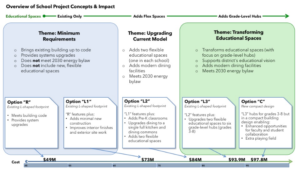 (Editor’s note: the links to articles and letters to the editor were updated on June 1, 2018.)
(Editor’s note: the links to articles and letters to the editor were updated on June 1, 2018.)
As a service to readers in advance of the Special Town Meeting on Saturday, June 9, here are links to past Lincoln Squirrel stories about the school project, as well as letters to the editor and some of the documents cited in those stories.
The articles go back to late 2012, shortly after the last town-wide school project vote took place—and also when the Lincoln Squirrel began publication. For earlier school project history, information on educational impacts, and all official documents, see the School Building Committee website.
Details on the June 9 meeting
- New check-in procedure for Town Meeting
- Agenda and procedure
- Construction phasing, Town Meeting child care
Charts and slide decks
- Drawings of the six school options along with costs and tax impacts for each
- A chart comparing the features and costs of the options
- The Finance Committee’s tax impact projections and comparisons to other area towns
- The SBC’s guiding principles
- Dore and Whitter summary of renovation and construction options (2015)
News articles
2018:
- Committees recommend school options L3 and C; selectmen also include L2 (5/31/18)
- Committees offer guidelines in advance of June 9 school vote (5/17/28)
- School and campus ideas come into clearer focus (3/26/18)
- 77% in survey prefer a mostly new school building (2/8/18)
- Workshops focus on three main school project options (1/26/18)
2017:
- Architects show how school design can enhance education (10/19/17)
- School Committee selects dual-firm design partnership (8/27/17)
- Voters give the go-ahead to school project and community center planning (3/26/17)
- Officials offer school recommendations, borrowing estimates (2/1/17)
- School Committee recommends Lincoln-only school project (1/29/17)
2016:
- State says no to Lincoln school funding for the third time (12/23/16)
- Residents vote to try for school funding again (3/21/16)
- Campus study group presents final report (2/12/16)
2015:
2014:
- Residents delve into community center, school project at State of the Town 11/17/14)
- School needs at least $27.5m even without cafeterias, architects say (11/11/14)
- McFall outlines educational needs for school (10/2/14)
- Residents approve up to $250,000 for another school study (4/3/14)
2013:
- State says no to Lincoln’s school building application (12/8/13)
- Group concludes that school needs everything in building plan (11/26/13)
- Town meeting approves funding for school project planning (4/2/13)
- Town to submit new statement of interest for school project (3/9/13)
- State says no to L-shaped school proposal (3/2/13)
- Town asks state to consider “L-shaped option for school (2/24/13)
2012:
Recent letters to the editor
- L3 is the best—not a compromise (Lis Herbert, 6/8/18)
- Stand up for Option C if education is your top priority (Paul Shorb, 6/8/18)
- Option L3 is the best choice (Peter Watkinson, 6/7/18)
- A look at the issues, and why I’m voting for L3 (Sara Mattes, 6/7/18)
- Mostue supports option L3 (Brooks Mostue, 6/7/18)
- A brief history of the school project (Gary Taylor, 6/6/18)
- C or L3 deliver opportunity for 21st-century education (Lincoln educators, 6/3/18)
- Support conservation and option L3 (Ken Bassett, 6/3/18)
- What is a net zero building? (Sue Klem, 5/31/18)
- LSF supports options L3 and C (Lincoln School Foundation, 5/31/18)
- Option C offers the most benefits (Fuat Koro, 5/29/18)
- Letter to the editor: do school repairs over a period of time (Jean Palmer, 5/29/18)
- Invest in the future with option L3 or C (Hans Bitter, 5/28/18)
- Vote for school option L3 (Ken Hurd, 5/24/18)
- School option C is best for sustainability (Mothers Out Front, 5/21/18)


